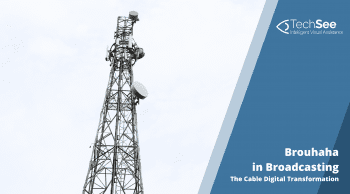
The cable industry is at a crossroads. No longer are consumers watching news, entertainment, and sports over a limited number of channels at specifically scheduled times of the day. The Internet, mobile technologies, and streaming channels have given consumers an unlimited source of viewing options over any device of their choice and are leading the industry as whole into a cable digital transformation.
On the one hand, this transition has caused cablecos to steadily lose customers. According to a cable industry analysis, the largest US cable operators saw a cable TV decline with 1.54 million customers cancelling their subscriptions during the first quarter of 2021. But on the other hand, this loss of customer base has primarily been from low-margin video subscribers, which has effectively shifted the industry’s customer mix to more profitable broadband customers.
McKinsey reports that cablecos still account for more than 60% of all connected homes, with the key providers averaging an impressive 25% return on invested capital. This profitability and market reach indicate significant growth potential for the cable industry if they can get in the game by embracing the cable digital transformation.
Factors Affecting the Cable Digital Transformation
Consumer shift toward streaming content
An increasing number of viewers are shifting to digital media due to the sheer array of options it presents. These web-based, over-the-top (OTT) media services such as Netflix and Amazon are negatively affecting the subscriber numbers for pay-TV. The move to streaming – known as “cord cutting” – is a growing trend. In 2010, there were 105 million customers with pay-TV; today eMarketer estimates that there are 74 million paying households and expects that number to drop another 10 million by 2023. Advertisers have taken note of this decline in cable subscribers and are increasingly shifting their dollars to digital channels to better target specific consumer segments.
Negative customer service perception
Although, like most industries, cable companies have upped their customer service game in recent years, ongoing jokes about “waiting for the cable guy” abound, and cablecos still consistently rank among the most disliked companies in consumer surveys.
Today’s on-demand consumers don’t want to hear that there are no same-day appointments for a home visit or that they will need to miss a day of work to be around during the cableco’s 6-hour service window. Billing errors are notorious, with McKinsey estimating that 10% of the customer base must call every month to report a billing issue. In addition, consumer preference for self-service has not made an impression at pay-TV providers, as less than half of subscribers trying to self-install their cable hardware manage to achieve their goal.
Strategies to ensure a future of cable TV
For cable companies to position themselves for growth and compete with emerging technologies, they must embrace the digital revolution and focus on their unique advantages.
Provide digital-first experiences
Customers are the cable companies’ secret weapon, and they must be nurtured for their full potential to be leveraged. These customers demand the same seamless end-to-end digital experiences they have learned to expect from their bank and favorite retail store.
To meet these expectations, cablecos must overhaul their operations to ensure that all aspects of their business are aligned with the digital revolution, from improved self-service options to personalized marketing to omnichannel customer service channels. Cablecos that can pivot to provide better customer experiences can expect to realize 2% to 5% top-line growth, significant improvements in CSAT metrics, and up to 5% savings in operating expenses.
Monetize available customer data
Cable companies can leverage the available household data collected across all their digital platforms, including customer details, channel preferences, and watch list history. Analyzing this data will allow them to offer customized entertainment and other content to their customers at the most optimized price, further strengthening their relationship.
In addition, cablecos can use their subscribers’ data to boost their advantage with advertisers. By harnessing non-personally identifiable data and targeting capabilities, cablecos can develop advanced data-driven ad products to benefit advertisers. Armed with targeted data from a larger audience than their OTT competitors, these cable companies can charge advertisers a higher CPM than before.
Become a smart-home player
The growing smart home market, projected to reach more than $495 billion by 2028, represents a new opportunity in the realm of cable digital transformation. Currently, cablecos have not made much headway into the smart home space. But considering their impressive customer reach, they are well-positioned to capitalize on their customer relationships to introduce smart home products and services to millions of their connected households.
In addition, their existing field service technicians can be put to good use by helping customers with a major pain point: installing and configuring smart home sensors and devices. Pay-TV’s subscription-based billing model can further entice consumers by allowing them to add the smart home service charges to their monthly bills rather than having to lay out the money upfront for a standalone smart home solution.
Cable industry analysis – in conclusion
In today’s digital age, the cable industry has seen media production, distribution, and consumption, as well as their customers’ expectations for service, change drastically. Operators that can embrace the cable digital transformation and introduce new, customer-centric strategies have a much better chance at overcoming the unique challenges that potentially contribute to the cable TV cord cutting phenomenon. Providing customers with digital-first experiences, monetizing available customer data, and moving into the smart home space are all practical approaches that will help cablecos advance growth in the future of cable TV.
This article was first published on the TechSee blog.



